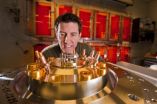(Press-News.org) ST. LOUIS – Many U.S. schools are not prepared for bioterrorism attacks, outbreaks of emerging infectious diseases or pandemics, despite the recent 2009 H1N1 influenza pandemic that resulted in more than 18,000 deaths worldwide, Saint Louis University researchers say.
The study, led by Terri Rebmann, Ph.D., associate professor at SLU's Institute for Biosecurity, surveyed about 2000 nurses working in elementary, middle and high schools across 26 states. The findings reveal that only 48 percent of schools address pandemic preparedness and only 40 percent of schools have updated their plans since the 2009 H1N1 pandemic that spread illnesses in more than 214 countries.
"There is a lot of research that shows influenza spreads quickly in schools because it's a communicable disease and kids interact closely," Rebmann said. "Schools need to have a written pandemic plan in order to be prepared to put interventions into place quickly when an event occurs."
The study suggests that every school should review and update its pandemic preparedness plan annually and address gaps in infectious disease emergency planning. Schools also need to coordinate these plans with the local and regional disaster response agencies, and organize disaster drills and exercises, including holding drills that involve an infectious disease scenario.
Published in the American Journal of Infection Control, the study also found that 44 percent of schools do not participate in community surveillance that tracks the presence of a disease based upon symptoms reported by area residents. These efforts are coordinated through local public health departments to assess indicators of biological threats.
One reason for lack in participation is that many communities may not have a surveillance program that uses school data as an indicator, said Rebmann. Another reason is that several schools might share a nurse, which can lead to inconsistent, inaccurate or unreported data.
In order to have a regular and strong pandemic preparedness program, Rebmann suggests that school nurses should be involved in building and assessing the plan.
"Health care professionals can best inform school administrators about unique aspects of pandemic planning that need to be included in school disaster plans," she said. "Results from this study indicate that better prepared schools were ones that involved their nurses in the disaster planning committee. The school nurse is the best person in a school district to know about infection control and be able to make recommendations about the best interventions to implement during a biological event."
INFORMATION:
Accredited since 1991, Saint Louis University School of Public Health is the only accredited school of public health in Missouri. It is one of 47 fully accredited public health schools in the U.S. and the only accredited Jesuit or Catholic school in the nation.
Majority of US Schools not ready for next pandemic, SLU researchers say
2012-09-17
ELSE PRESS RELEASES FROM THIS DATE:
AGU journal highlights – 17 September 2012
2012-09-17
The following highlights summarize research papers that have been recently published in Geophysical Research Letters (GRL), Journal of Geophysical Research – Solid Earth (JGR-B), Journal of Geophysical Research – Planets (JGR-E), Journal of Geophysical Research – Earth Surface (JGR-F), Journal of Geophysical Research – Biogeosciences (JGR-G).
In this release:
1. Characterizing the surface composition of Mercury
2. African dust forms red soils in Bermuda
3. Sea level controls carbon accumulation in the Everglades
4. Climate change threatens permafrost in soil
5. ...
Dry-run experiments verify key aspect of Sandia nuclear fusion concept
2012-09-17
ALBUQUERQUE, N.M. — Magnetically imploded tubes called liners, intended to help produce controlled nuclear fusion at scientific "break-even" energies or better within the next few years, have functioned successfully in preliminary tests, according to a Sandia research paper accepted for publication by Physical Review Letters (PRL).
To exceed scientific break-even is the most hotly sought-after goal of fusion research, in which the energy released by a fusion reaction is greater than the energy put into it — an achievement that would have extraordinary energy and defense ...
Further steps needed to reduce stigma and expand access to substance abuse
2012-09-17
WASHINGTON — Outdated approaches to preventing and treating substance abuse, barriers to care, and other problems hinder the U.S. Defense Department's ability to curb substance use disorders among military service members and their families, says a new report from the Institute of Medicine. Service members' rising rate of prescription drug addiction and their difficulty in accessing adequate treatment for alcohol and drug-related disorders were among the concerns that prompted members of Congress to request this review.
"We commend the steps that the Department of Defense ...
Berkeley Lab sensors enable first light for the dark energy camera
2012-09-17
Early in the morning of September 12 the Dark Energy Camera (DECam), mounted on the Victor Blanco Telescope at the Cerro Tololo Inter-American Observatory in Chile, recorded its first images of a southern sky spangled with galaxies. Galaxies up to eight billion light years away were captured on DECam's focal plane, whose imager consists of 62 charge-coupled devices (CCDs) invented and developed by engineers and physicists at the U.S. Department of Energy's Lawrence Berkeley National Laboratory (Berkeley Lab).
Berkeley Lab CCDs are noted for their exceptionally high ...
World's most powerful digital camera opens eye, records first images in hunt for dark energy
2012-09-17
Eight billion years ago, rays of light from distant galaxies began their long journey to Earth. That ancient starlight has now found its way to a mountaintop in Chile, where the newly constructed Dark Energy Camera, the most powerful sky-mapping machine ever created, has captured and recorded it for the first time.
That light may hold within it the answer to one of the biggest mysteries in physics – why the expansion of the universe is speeding up.
Scientists in the international Dark Energy Survey collaboration announced this week that the Dark Energy Camera, the ...
Improving memory for specific events can alleviate symptoms of depression
2012-09-17
Hear the word "party" and memories of your 8th birthday sleepover or the big bash you attended last New Year's may come rushing to mind. But it's exactly these kinds of memories, embedded in a specific place and time, that people with depression have difficulty recalling.
Research has shown that people who suffer from, or are at risk of, depression have difficulty tapping into specific memories from their own past, an impairment that affects their ability to solve problems and leads them to focus on feelings of distress.
In a study forthcoming in Clinical Psychological ...
Home Security That's a Perfect Fit for Your Lifestyle
2012-09-17
LifeShield Security is proud to announce LifeShield Lifestyles, a unique tool to help consumers to choose home security systems and products that fit their routines and personalities. By offering security systems that are designed for individuals, families, and real-life situations, LifeShield is continuing its mission to go "beyond the alarm" and provide advanced technology wireless security and peace of mind.
"Home security is really about people, not houses. Homeowners and renters don't install alarm systems to protect walls, ceilings and doors. They ...
Flu antibody’s 'one-handed grab' may boost effort toward universal vaccine, new therapies
2012-09-17
LA JOLLA, CA -- Scientists from The Scripps Research Institute and Sea Lane Biotechnologies have solved the co-crystal structure of a human antibody that can neutralize influenza viruses in a unique way. The antibody recognizes the crucial structure that flu viruses use to attach to host cells, even though previously this structure had been thought too small for an antibody to grab effectively. The immune protein manages to hit this precise spot by using just a small part of its target-grabbing apparatus. In so doing, it can neutralize a broad range of dangerous flu viruses.
"This ...
Most coral reefs are at risk unless climate change is drastically limited
2012-09-17
Only under a scenario with strong action on mitigating greenhouse-gas emissions and the assumption that corals can adapt at extremely rapid rates, could two thirds of them be safe, shows a study now published in Nature Climate Change. Otherwise all coral reefs are expected to be subject to severe degradation.
Coral reefs house almost a quarter of the species in the oceans and provide critical services – including coastal protection, tourism and fishing – to millions of people worldwide. Global warming and ocean acidification, both driven by human-caused CO2 emissions, ...
Chemists develop reversible method of tagging proteins
2012-09-17
Chemists at UC San Diego have developed a method that for the first time provides scientists the ability to attach chemical probes onto proteins and subsequently remove them in a repeatable cycle.
Their achievement, detailed in a paper that appears online this week in the journal Nature Methods, will allow researchers to better understand the biochemistry of naturally formed proteins in order to create better antibiotics, anti-cancer drugs, biofuels, food crops and other natural products. It will also provide scientists with a new laboratory tool they can use to purify ...



